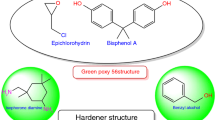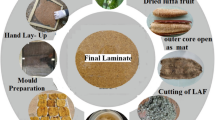Abstract
The fundamental theory for discontinuous fibre reinforcement of plastics is reviewed and compared to experimental data obtained from a range of single-fibre composite tests. Given that the theory provides an adequate description of fibre reinforcement, predictions for the critical fibre length in model composites based on glass fibres embedded in a range of matrices with different volume fractions have been made. The model has been used to predict the modulus for unidirectional discontinuous glass fibre-reinforced composites with a high volume fraction of glass fibres with different mean fibre lengths, diameters and matrices. From this study the concept of a critical aspect ratio, required for effective composite performance, has been defined generally for this type of material. The critical aspect ratio has been found to depend upon fibre diameter, matrix modulus and fibre volume fraction. A brief review of this class of material in the scientific literature has been made in the areas of deformation and failure. To aid the developments in the theory behind discontinuous fibre composites, a series of deformation experiments have been performed on model discontinuous glass fibre/nylon 6,6 compounds produced by extrusion and pultrusion compound technology. The materials were processed using multilive feed technology, to produce effective representations of unidirectional discontinuous glass-fibre composites. Given that the model compounds contained variations in fibre lengths and diameters, the deformation experiments performed were a fundamental test of the theory presented for the critical fibre aspect ratio and the results of theory and experiment have been compared. Based on the predictions of the model and the experimental work, conclusions are offered on the type of fibre that should be used for discontinuous fibre-reinforced composites.
Similar content being viewed by others
References
Eur. Plastics News (March) (1993) 21.
H. L. Cox, Br. J. Appl. Phys. 3 (1952) 72.
G. S. Hollister and C. Thomas, “Fibre Reinforced Materials” (Elsevier, 1966).
T. S. Chow, J. Mater. Sci. 15 (1980) 1873.
E. I. M. Asloun, M. Nardin and J. Schulz, ibid. 24 (1989) 1835.
C. Galiotis, Compos. Sci. Technol. 42 (1991) 125.
C. Galiotis, R. J. Young, P. H. J. Yeung and D. N. Batchelder J. Mater. Sci. 19 (1984) 3640.
L. Monette, M. P. Anderson, S. Ling and G. S. Grist, ibid. 27 (1992) 4393.
B. W. Rosen, AIAA J. 2 (1964) 1985.
Y. Termonia, J. Mater. Sci. 22 (1987) 504.
M. R. Piggott, Polym. Compos. 8 (1987) 291.
Idem, M. R. Piggott, Compos. Sci. Technol. 42 (1991) 57.
J. C. Figueroa, T. E. Carney, L. S. Schadler and C. Laird, ibid. 42 (1991) 77.
M. Narkis, E. J. H. Chen and R. B. Pipes, Polym. Compos. 9 (1988) 245.
N. Melanitis and C. Galiotis, Proc. R. Soc. Lond. A 440 (1993) 379.
R. J. Young, in “Polymer surfaces and interfaces II”, edited by W. J. Feast, H. S. Munro and R. W. Richards (Wiley, 1993) Ch. 6.
R. J. Day and R. J. Young, J. Micros. 169 (1993) 151.
C. Galiotis, R. J. Young, P. H. J. Yeung and D. N. Batchelder, J. Mater. Sci. 19 (1984) 3640.
I. M. Robinson, P. H. J. Yeung, R. J. Young and C. Galiotis, ibid. 21 (1986) 3642.
I. M. Robinson, R. J. Young, C. Galiotis and D. N. Batchelder, ibid. 22 (1987) 3642.
I. M. Robinson, C. Galiotis, D. N. Batchelder and R. J. Young, ibid. 26 (1991) 2293.
H. Jakankhani and C. Galiotis, J. Compos. Mater. 25 (1991) 609.
M. C. Andrews and R. J. Young, J. Raman Spec.
M. C. Andrews, R. J. Day, X. Hu and R. J. Young, J. Mater. Sci. Lett 11 (1992) 1344.
N. Melanitis, C. Galiotis, P. L. Tetlow and C. K. L. Davies, J. Compos. Mater. 26 (1992) 574.
N. Melanitis, C. Galiotis, P. L. Tetlow and C. K. L. Davies J. Mater. Sci. 28 (1993) 1648.
W. D. Bascom and R. M. Jensen, J. Adhesion 19 (1986) 219.
A. T. Dibenedetto, Compos. Sci. Technol. 42 (1991) 103.
N. Laws and R. MćLaughlin, J. Mech. Phys. Solids 27 (1979) 1.
C. R. Gore, G. Cuff and D. A. Cianelli, Mater. Eng. 103 (1986) 47.
M. Davies, R. S. Bailey and D. R. Moore, Composites 20 (1989) 453.
D. R. Moore, I. M. Robinsonand B. Slater,in “FRC 90” (Institute of Mechanical Engineers, London, 1990) p. 203.
R. S. Bailey and H. Kraft, Int. Polym. Proc. 2 (1987) 94.
R. S. Bailey, D. R. Moore, I. M. Robinson and P. M. Rutter, Sci. Eng. Compos. Mater. 2 (1993) 171.
M. J. Carling and J. G. Willams, Polym. Compos. 11 (1990) 307.
F. Ramsteiner and R. Theysohn, Compos. Sci. Technol. 24 (1985) 231.
Idem, Composites 10 (1979) 111.
F. Ramstiner, ibid. 12 (1981) 65.
N. Sato, T. Kurauchi, S. Sato and O. Kamigaito, J. Compos. Mater. 22 (1988) 850.
M. Akay and D. Barkley, J. Mater. Sci. 26 (1991) 2731.
N. Sato, T. Kurauchi, S. Sato and O. Kamigaito, J. Mater. Sci. 26 (1991) 3891.
S. Turner, Br. Plast. (April) (1972) p. 7.
Author information
Authors and Affiliations
Rights and permissions
About this article
Cite this article
Robinson, I.M., Robinson, J.M. The influence of fibre aspect ratio on the deformation of discontinuous fibre-reinforced composites. Journal of Materials Science 29, 4663–4677 (1994). https://doi.org/10.1007/BF00356507
Received:
Accepted:
Published:
Issue Date:
DOI: https://doi.org/10.1007/BF00356507




